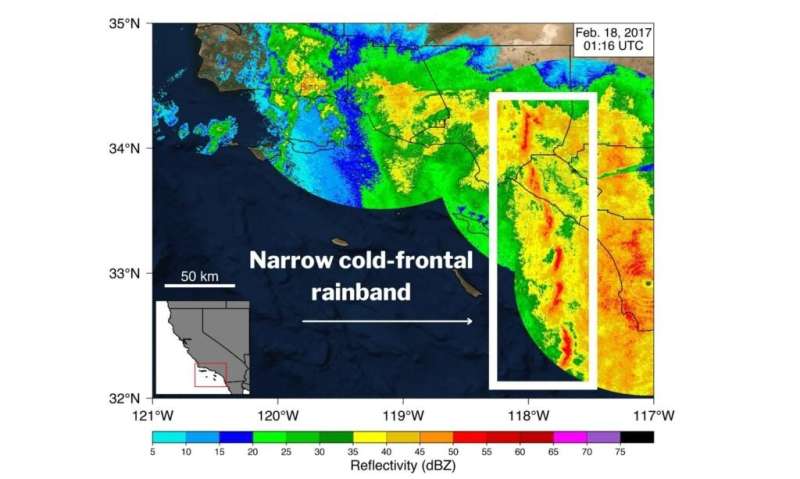New study improves understanding of Southern California's intense winter rains

New research looks to improve prediction of brief but intense rainstorms that can cause devastating flash floods and landslides.
The storms, called narrow cold-frontal rainbands, are long strips of rain that can stretch for tens to hundreds of kilometers in length but are only a few kilometers wide. They form along many of the world's coasts, including both coasts of the U.S.
Intense rain associated with narrow cold-frontal rainbands may last only a few minutes at a particular location, yet the rain can cause catastrophic flash flooding, debris flows and landslides, and can occur along with tornadoes and severe thunderstorms. With all these potential hazards, the storms can prompt broad evacuation alerts. But predicting when and where the intense rain will both hit and cause hazards is difficult, and evacuations can be issued over too large an area. Improving predictions of these atmospheric phenomena is important for avoiding evacuation fatigue and maintaining public trust in warning systems.
A new study analyzes three decades of radar and hazard-warning data from southern California, building a catalog of rainbands that will help improve predictions of when and where these events will be dangerous. The study was published in the AGU journal Geophysical Research Letters, which publishes high-impact, short-format reports with immediate implications spanning all Earth and space sciences.
Researchers found that from 1995 to 2020, 60% of these events resulted in at least one National Weather Service warning, and 15 of the 94 events led to 10 or more warnings as the bands swept across southern California. Some of the most intense events were associated with atmospheric rivers. And most hit in the region's already-wet winter months of January through March.
The new catalog of rainbands will help scientists create storm prediction and tracking algorithms, with the eventual goal of "nowcasting" the storms: Predicting their patterns and hazards just a few hours in advance.
Improving predictions is necessary to help people who live in potentially affected areas, says study co-author Nina Oakley, an atmospheric scientist at the Scripps Institution of Oceanography.
"Our current predictive models struggle with location, timing and intensity of these events, and we need to improve that for evacuation warnings. … If we issue evacuation warnings for what turns out not to be a high-impact event, you start to run into evacuation fatigue, where people might not trust the warnings in the future," says Oakley.
Searching the clouds
To discern how frequently, when and where the rainbands occur, the researchers manually examined years of radar data, searching for telltale "gap and core" patterns of these rainbands, and paired their results with hazard warnings from the National Weather Service over the same time period.
They found the number of narrow cold-frontal rainband events varied widely, from a total absence of these features to about a dozen per year, with most occurring between January and March. Approximately 60% of the events between 1995 and 2020 resulted in at least one warning from the National Weather Service and 15 exceptionally intense events resulted in 10 or more warnings of flash floods, tornadoes or debris flow and landslide risk as they swept across Southern California.
"All but two of these intense rainband events were associated with atmospheric rivers, and two-thirds of our entire catalog were as well," says Marian de Orla-Barile, lead study author and geography Ph.D. student at the University of California, Santa Barbara. High water vapor content in the atmosphere and intensifying low-pressure systems were also commonly associated with the rainbands.
"Narrow cold-frontal rainbands produce some of the highest rainfalls of any extra-tropical cyclone precipitation band," says Brian Collins, a geomorphologist at the USGS who was not involved in the study. "The hazards vary depending on where you are, but they key part of the equation is a lot of rain in a really short time."
Predicting disaster
The short timeframe Collins mentions highlights one of the difficulties in forecasting damage. The study's catalog of narrow cold-frontal rainbands is an early, critical step in building an algorithm that can automatically identify and track areas of intense, potentially damaging rain. Such an algorithm is the heart of "nowcasting," which aims to forecast rainfall within hours. Ultimately, as the algorithm and its database are improved, predicting storm tracks and impacts will be within reach.
Because the rainbands can strengthen or weaken over time, especially as they encounter mountainous topography, pinpointing when and where they will produce the most intense rainfall and pose hazards is difficult. Not all narrow cold-frontal rainbands produce disastrous rainfall, nor do all pass over a populated area below a recent wildfire burn scar or landslide hazard area that would need to evacuate.
"A lot of times, warnings are issued for large areas because of the uncertainty in where the rain band will have that high-intensity precipitation. So you end up warning a larger area than needs to be warned," says Collins. Taking local conditions into account—such as recent wildfires or heavy rains that may have saturated the soil, making slopes prone to landslides—is important for predicting narrow cold-frontal rainband hazard risks, Collins stresses.
"With projected increases in wildfires as well as the projected intensification of short-duration rainfall, it's likely that in a warming climate, there will be increased post-fire debris flow events," some of which could be associated with narrow cold-front rainbands, says de Orla-Barile.
More information: Marian Orla‐Barile et al, A Climatology of Narrow Cold‐Frontal Rainbands in Southern California, Geophysical Research Letters (2021). DOI: 10.1029/2021GL095362
Journal information: Geophysical Research Letters
Provided by American Geophysical Union




















